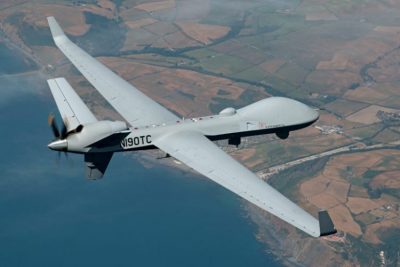New Details of US Drone Flights in UK this Summer Raise Concerns over Safety and Corporate Cronyism

All Global Research articles can be read in 27 languages by activating the “Translate Website” drop down menu on the top banner of our home page (Desktop version).
***
New details about the British government’s plans to allow US defence manufacturer General Atomics to conduct experimental flights of its new SkyGuardian drone in the UK this summer have emerged in MOD documents published on the Civil Aviation Authority’s (CAA) website.
SkyGuardian flights are to be conducted from RAF Waddington in Lincolnshire, beginning in July and lasting until September, and then from RAF Lossiemouth in North East Scotland, until mid to late October. The RAF is acquiring a version of the SkyGuardian drone, which it is calling Protector, and which will be modified for UK requirements. Protector will enter service in 2023 to replace the UK’s current Reaper armed drone fleet. General Atomics’ SkyGuardian flights are significant because they signal the coming integration of large drones, such as Protector, into UK airspace. This is set to further normalise the use of large drones within the UK, not only by the military, but a host of other operators.
The planned SkyGuardian flights also raise concerns over safety and questions about undue corporate influence over the UK government and airspace regulators. In terms of safety, both RAF Waddington and RAF Lossiemouth are surrounded by houses, school buildings and local businesses. Planned flights of the same drone over San Diego in the US last year did not go ahead, apparently after safety objections from US airspace regulator, the Federal Aviation Authority (FAA). The flights instead took place away well from populated areas. US and British armed forces have regularly flown large drones for more than twenty years, yet the constant communication links which they rely on are often lost. Such drones also continue to crash for several other reasons—including poor maintenance and pilot error. Recent public polling carried out for UK Drone Watch found that 67% of respondents were worried about the safety implication of large drones flying in the UK, with 70% agreeing that such flights should be kept to segregated airspace.
The UK Ministry of Defence (MOD) has applied to the UK’s airspace regulator – the CAA – for a ‘temporary danger area’ to be established around both RAF Waddington and RAF Lossiemouth. This is to provide segregated airspace for up to 10,000 feet for approximately 10 miles around the bases to separate SkyGuardian from other aircraft as it takes off and lands. However, above this height, and for much of the time SkyGuardian will be flying in the UK, it will be unsegregated. Therefore, when the CAA makes its decision (in mid-April) on whether to approve the SkyGuardian flights, it will also need to consider if the on-board Detect and Avoid (DAA) technology that the aircraft will be equipped with meets UK air safety requirements.

A DAA capability is required for drones wishing to fly outside segregated airspace, and beyond visual line of sight (BVLOS) of the pilot. The MOD has argued that such technology has been approved by the FAA for use in the US and hopes it will meet UK safety standards, whilst noting the ‘differences between airspace in the UK and the USA’. Moreover, the FAA only granted an ‘experimental certificate with caveats’ and this was awarded based on data about the safety of SkyGuardian provided by General Atomics itself. The recent drone crash near Gatwick Airport shows what can happen when there is not rigorous assessment of such aircraft by independent authorities. The CAA’s review of the DAA system that General Atomics want SkyGuardian to use in the UK must therefore be of the highest standard.
UK airspace is being used as a guinea pig by General Atomics not only to test their new technology, but also to show off their latest hardware to other potential customers. During the visit, SkyGuardian is set to undertake ‘a series of operational capability demonstrations’ for the UK, and other NATO members, and demonstrate the drone’s maritime capability. The drone will also participate in the UK’s Joint Warrior Exercise in late September over Scotland and the North Sea. General Atomics could potentially make billions of dollars from sales of their new drones if they can eventually get approval from airspace regulators to fly them in unsegregated domestic airspace and thus market SkyGuardian as being ‘civilian airspace compliant’.
The MOD documents published on the CAA’s website identify several ‘opportunities’ that the SkyGuardian flights provide to interested parties. These include:
- progressing the integration into UK airspace of ‘future State RPAS’ i.e., Remotely Piloted Air Systems, such as Protector.
- testing the design of the long-term airspace changes proposed by the MOD to allow Protector to fly from RAF Waddington.
- demonstrating SkyGuardian ‘against current military assets’—including other RAF aircraft, such as Typhoon.
- demonstrating SkyGuardian to ‘other Government Departments’ including the UK’s Maritime and Coastguard Agency and Border Force.
- providing ‘fly-bys’ at air shows and the Belgian Air Force’s 75th Anniversary event
General Atomics should not be allowed to use the UK’s airspace as a glorified testing ground and showroom just so they can sell armed drones to US allies. Airspace regulators appear to be under pressure from the Ministry of Defence and government ministers to approve these flights despite questions about the safety of the technology involved. Residents of Lincolnshire, North East Scotland—and those living in between—need to know the risks of large military drones being flown over their homes and workplaces. Drone Wars strongly opposes this proposal and we shall be working with MPs, peers and the public to challenge it.
*
Note to readers: please click the share buttons above or below. Forward this article to your email lists. Crosspost on your blog site, internet forums. etc.
Featured image is from Drone Wars UK

